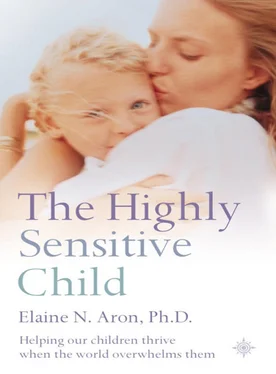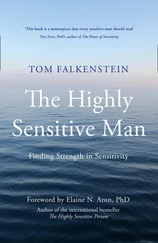Yet this is a quality of HSCs that parents can easily appreciate, too. HSCs are not as likely to fall from trees, get lost, be hit by a car, try smoking, or be abducted or misused by a disturbed adult. You warned them of the dangers and they check every unfamiliar situation to see if those dangers are present. It is even better with teenagers. They are better drivers (or will not drive—my son did not wish to take on that huge responsibility until he was twenty-seven). They are cautious about drugs, sex, breaking the law, and who they hang around with.
But you also do not want your child to miss out on interesting new experiences, as when Maria, the HSC described at the beginning of this chapter, was invited as a teenager to travel to Sweden. She insisted that she would not go, but her mother insisted that she would; later, a happy call from Stockholm proved her mother correct.
There are times, of course, when HSCs are not so cautious in new situations. In Chapter 1you learned about the pause-to-check and go-for-it systems in every brain. All HSCs are strong in the first, but the two systems are independent, so some HSCs are high on both. They are careful, but also adventuresome. In that chapter I described Ann, who rides motorcycles and jumps out of airplanes, but only her parents know how much she has studied the safety considerations and how much down time she needs to recover. You also met Chuck, who climbs trees like a monkey and loves to ski. But only his mother knows he has never broken a bone because he has checked out every unfamiliar branch and slope. Since the culture admires and encourages adventuresomeness, often only the parents know their child’s secret, cautious side.
We will talk more about the problems associated with pausing before proceeding and how to deal with them in Chapter 8and Chapter 9. But for now, here are some overall recommendations.
Remember the advantages of your child’s caution—this will help you not be disappointed when it seems “uncool.”
See it from your child’s viewpoint . You have been in this situation many times, but he has not. You no longer notice the cliff beside the road or the shadows on the path. And there may be fewer risks for you. These are not your future playmates; you are bigger so dogs and waves and cars look smaller; you are used to heavy jet planes staying in the air.
Point out what is familiar or what resembles past situations that your child has mastered . “The family reunion will be a lot like Grandma Mae’s birthday party.” “The ocean is just a huge bathtub and the waves are like the kind you make when you move around in your bath.” “There’s Sue—you met her last week at Nancy’s party.”
Take it one step at a time . See Chapter 7for these steps. Keep each step small and easy so your child can hardly protest and will definitely succeed and look good. “You don’t have to talk to anybody if you don’t want to. Just come and watch. You can be busy with your Gameboy.” After some watching, you can try saying, “I’ll bet if you walk Tiger over to those swings, someone will ask you what kind of dog he is.”
Provide a retreat (if you can do so without drawing embarrassing attention to your child). “You can go to your room whenever you want to leave the party. Just slip out and I’ll cover for you if anyone asks.” “I’ve told the teacher you may want to go and rest—just tell her.”
Success is the key to your child exploring new situations in the future . Remember, all HSCs have a go-for-it system. They want to explore, as long as the risks do not seem too high. So point out all that they will gain from exploring (without going overboard) while minimizing the risks. “I was so impressed, seeing you out there in the deep end swimming like a fish. To think you couldn’t swim at all last summer. Next week you’ll be starting middle school and changing classes every period. Think of it—if one teacher’s a drag or you don’t like some kid in your class, you aren’t stuck all day. And you get to take those two electives you signed up for. You already know enough about computers and Native Americans to practically teach those classes yourself. I’ll bet it won’t be long before you’re ‘in the swim’ there, too.”
6. Being Different—It Attracts Attention
The sixth challenge when raising an HSC is not due to the trait directly, but the way others view it. Unless your child becomes very good at hiding it, she will be known as someone who feels and notices more, someone who pauses before acting and thinks everything over afterward. And it seems to be a human fact that when we meet someone different, especially a member of a minority group (and sensitive people are in the minority), we immediately decide if they are superior or inferior, if they look up to us or if we should look up to them. This is what any child who seems “different” must face.
As with the other six, there are also advantages in having a child who is different. Remember our motto: To have an exceptional child you have to be willing to have an exceptional child. Some teachers, peers, and relatives will think your child’s differences are marvelous. From these people your child will gain the self-esteem she will need when meeting up with some of the other people, the majority in our culture, who are less impressed with sensitivity.
Indeed, in some cultures it is a social advantage, an honor, to be sensitive. Peoples living close to the earth esteem their highly sensitive herbalists, trackers, and shamans. And a study comparing elementary school children in China and Canada found that being a “sensitive, quiet” child was associated with being popular in China, but with being unpopular in Canada. Perhaps “old” cultures with rich artistic, philosophical, and spiritual traditions such as China and Europe can afford to reward sensitivity more than “new” immigrant cultures such as the United States, Canada, Latin America, and Australia, which have rewarded pioneering “macho” men and “tough” women who gave little thought to the risks in a new land.
If you think about it, cultures that are tough, aggressive, impulsive, and quick to explore are the ones that expand and take over cultures with more peaceful, thoughtful, sensitive values—whether with an army, an aggressive economic style, or the dissemination of its culture. But this may be a story of the tortoise and the hare—the individuals and cultures that value sensitivity may yet be the survivors. Or, more likely, the cultures that succeed will be the ones combining both qualities, that balance impulsivity with a thorough awareness of the long-term consequences of despoiling natural re-sources; exploiting “inferior” groups until they become a burden or take their revenge; not bothering to educate the young; and so forth. A society in which sensitive people have equal respect and power will not make these mistakes. As I’ve said before, the world needs your HSC.
We will discuss in Chapter 5what you can do to empower your HSC and protect her from prejudices about sensitivity, but here are some basic pointers:
Examine your own attitude toward this trait . Research shows that almost everyone who grew up in North America has a subliminal, unconscious prejudice toward persons of color. Those who decide not to behave in a prejudiced way are those who actively override this built-in reaction. Likewise, since you grew up in a culture that thinks “sensitive, quiet” children are not as admirable, you must override this reaction for the sake of your child. And it can be quite real. Research indicates that “shy” sons, in particular, are often their mother’s least favorite child (while “shy” daughters are often encouraged to stay home and be mother’s special friend).
Читать дальше











